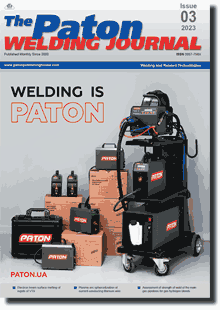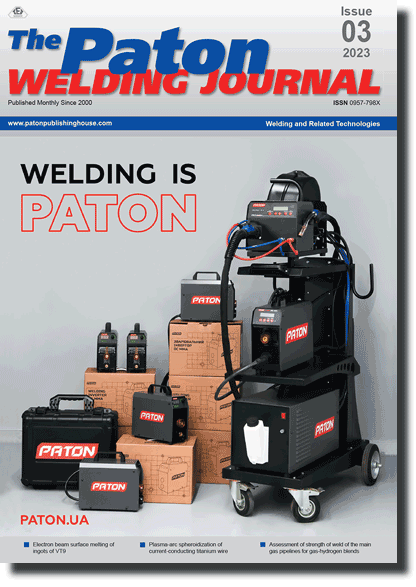| 2023 №03 (06) |
DOI of Article 10.37434/tpwj2023.03.07 |
2023 №03 (01) |

The Paton Welding Journal, 2023, #3, 51-56 pages
Numerical assessment of brittle strength of field welds of the main gas pipelines at transportation of gas-hydrogen mixtures
O.S. Milenin, O.A. Velikoivanenko, G.P. Rozynka, N.I. Pivtorak
E.O. Paton Electric Welding Institute of the NASU. 11 Kazymyr Malevych Str., 03150, Kyiv, Ukraine. E-mail: asmilenin@ukr.net
Abstract
Features of the influence of hydrogen degradation of pipe steel on brittle strength of circumferential field welded joints were considered within the framework of analysis of the possibility of using the Ukrainian gas-transportation system for transportation of mixtures of natural gas and hydrogen. Applied for these purposes were the methods of finite-element modeling of the structure stress-strain state during welding and further service together with modern criteria of macroscopic fracture of a cracked body. Results of prediction of brittle strength margin of a typical welded section of the main gas pipeline with postulated surface cracks at transportation of gas-hydrogen mixtures of different composition showed that the areas of the weld and heat-affected zone are the most prone to brittle fracture. However, as regards fatigue strength of welded joints, greater ranges of stress intensity factors in the heat-affected zone under the impact of cyclic loading by inner pressure or bending moment, result in an essential reduction of the residual strength margins at prediction of long-term brittle strength. 15 Ref., 1 Tabl., 7 Fig.
Keywords: gas-hydrogen mixture, main gas pipeline, hydrogen degradation, technical condition, brittle strength, cyclic loading
Received: 06.10.2023
Accepted: 24.04.2023
References
1. Nechaev, Yu.S. (2008) Physical complex problems of aging, embrittlement and fracture of metallic materials in hydrogen power engineering and main pipelines. Uspekhi Fizicheskikh Nauk, Vol. 178(7), 709-726 [in Russian]. 2. Esaklul, K.A. (2017) Hydrogen damage.2. Esaklul, K.A. (2017) Hydrogen damage. Trends in Oil and Gas Corrosion Research and Technologies Production and Transmission. UK: Woodhead Publishing, 315-340. https://doi.org/10.1016/B978-0-08-101105-8.00013-9
3. Dmytrakh, I., Syrotyuk, A., Leshchak, R. (2022) Specific mechanism of hydrogen influence on deformability and fracture of low-alloyed pipeline steel. Procedia Structural Integrity, 36, 298-305. https://doi.org/10.1016/j.prostr.2022.01.038
4. Nykyforchyn, H., Lunarska, E., Tsyrulnyk, O.T. et al. (2010) Environmentally assisted «in-bulk» steel degradation of long term service gas trunkline. Engineering Failure Analysis, 17, 3, 624-632. https://doi.org/10.1016/j.engfailanal.2009.04.007
5. Milenin, O.S., Velykoivanenko, O.A., Rozynka, G.P., Pivtorak, N.I. (2022) Features of analysis of the technical state and support of reliability of the main gas pipelines at transportation of gas-hydrogen mixtures (Review). The Paton Welding J., 6, 49-56. https://doi.org/10.37434/tpwj2022.06.07
6. Karkhin, V.A. (2019) Thermal Processes in Welding. Singapore, Springer Singapore. https://doi.org/10.1007/978-981-13-5965-1
7. Makhnenko, V. (2013) Problems of examination of modern critical welded structures. The Paton Welding J., 5, 21-28.
8. Milenin, A., Velikoivanenko, E., Rozynka, G., Pivtorak, N. (2019) Probabilistic procedure for numerical assessment of corroded pipeline strength and operability. International Journal of Pressure Vessels and Piping, 171C, 60-68. https://doi.org/10.1016/j.ijpvp.2019.02.003
9. (2015) BS 7910:2013+A1:2015 Guide to methods for assessing the acceptability of flaws in metallic structures. The British Standards Institution.
10. (2007) Fitness-For-Service. API 579-1/ASME FFS-1. Recommended Practice 579. Second edition. Washington, API Publishing Services.
11. (1997) SNiP 2.05.06-85. Main pipelines. Building norms and rules. Moscow, VNIIST Minneftegazstroj [in Russian].
12. Hobbacher, A. (2008) Recommendations for Fatigue Design of Welded Joints and Components. International Institute of Welding. Doc. XIII-2151r4-07/XV-1254r4-07. Paris, France, October 2008.
13. Furrer, D.U., Semiatin, S.L. (2009) ASM Handbook. Volume 22A. Fundamentals of Modeling for Metals Processing. Edit. Ohio, ASM International. https://doi.org/10.31399/asm.hb.v22a.9781627081962
14. Meng, B., Gu, C.H., Zhang, L. et al. (2017) Hydrogen effects on X80 pipeline steel in high-pressure natural gas/ hydrogen mixtures. International Journal of Hydrogen Energy, 42, 11, 7404-7412. https://doi.org/10.1016/j.ijhydene.2016.05.145
15. Stalheim, D., Boggess, T., SanMarchi, C. et al. (2010) Microstructure and mechanical property performance of commercial grade API pipeline steels in high pressure gaseous hydrogen. In: Proceedings of IPC 2010 8th International Pipeline Conference Calgary, Canada. https://doi.org/10.1115/IPC2010-31301
Suggested Citation
O.S. Milenin, O.A. Velikoivanenko, G.P. Rozynka, N.I. Pivtorak (2023) Numerical assessment of brittle strength of field welds of the main gas pipelines at transportation of gas-hydrogen mixtures. The Paton Welding J., 03, 51-56.The cost of subscription/purchase order journals or individual articles
| Journal/Currency | Annual Set | 1 issue printed |
1 issue |
one article |
| TPWJ/USD | 384 $ | 32 $ | 26 $ | 13 $ |
| TPWJ/EUR | 348 € | 29 € | 24 € | 12 € |
| TPWJ/UAH | 7200 UAH | 600 UAH | 600 UAH | 280 UAH |
| AS/UAH | 1800 UAH | 300 UAH | 300 UAH | 150 UAH |
| AS/USD | 192 $ | 32 $ | 26 $ | 13 $ |
| AS/EUR | 180 € | 30 € | 25 € | 12 € |
| SEM/UAH | 1200 UAH | 300 UAH | 300 UAH | 150 UAH |
| SEM/USD | 128 $ | 32 $ | 26 $ | 13 $ |
| SEM/EUR | 120 € | 30 € | 25 € | 12 € |
| TDNK/UAH | 1200 UAH | 300 UAH | 300 UAH | 150 UAH |
| TDNK/USD | 128 $ | 32 $ | 26 $ | 13 $ |
| TDNK/EUR | 120 € | 30 € | 25 € | 15 € |
AS = «Automatic Welding» - 6 issues per year;
TPWJ = «PATON WELDING JOURNAL» - 12 issues per year;
SEM = «Electrometallurgy Today» - 4 issues per year;
TDNK = «Technical Diagnostics and Non-Destructive Testing» - 4 issues per year.


